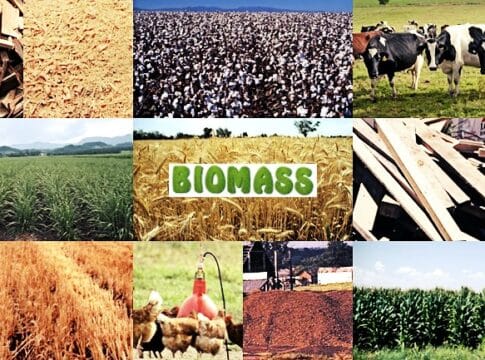The Evolution of Biomass and Its Generations
The rising global demand for energy and the draining of fossil fuel stocks have fueled the growing interest in biomass and its generations, particularly biofuels in the last decade or so.
But more critically, along with new discoveries and breakthroughs during the 20th century, humans also started to face one of the world’s most serious problems – climate change.
For the most part of that century, research on biomass almost followed the price of fossil oil. And there has been a growing concern on the environmental impact of liquid fuel use in the last five decades.
For example, more than 8 billion liters of gasoline are consumed to fuel transport vehicles each year in Canada. This and the alarming concern over carbon emissions led to greater attention on the use of biofuels. Their use often becomes a more eco-friendly option because their carbon balance is almost neutral while the fossil-derived fuels like diesel or gasoline are damaging to the planet.
This article will trace the evolution of biomass and its three generations, discussing their major attributes as well as their key benefits and advantages.
But first, let’s define what biomass is and why the world has to shift to using it for biofuels.
What is Biomass?
Biomass is renewable organic material, meaning it comes from living organisms such as plants and animals. It remains to be an important source of fuel in many countries and was the largest source of total annual energy consumption in the U.S. until the mid-1800s.
Biomass has always been a reliable source of energy that has been narrowed down to renewable sources of carbon.
Ethanol is one of the best known biofuel in the U.S.A. while other types of this fuel, e.g. biodiesel, are also used in other countries such as Asia and Europe.
In the early 19th century, ethanol was called spirit oil until it was tested and found useful for internal combustion engines. Ethanol phased out whale oil then it was replaced by petroleum distillate for lighting. At the end of the century, ethanol was introduced in the transportation sector.
At the turn of the 20th century, fossil-derived products replaced ethanol right until today. But with the intensifying issue on the planet-warming fossil oil, biomass starts to take the centerstage of energy production.
And though there are many ways to make clean energy from other renewable sources, biomass is vital because those other sources don’t create liquid fuels that can fuel transport vehicles. One thing, however, is that conversion of biomass into biofuel presents a big challenge. And the more complex the biomass chemical composition gets the more expensive the conversion process becomes.
The U.S. is the forerunner of the biofuel market, aiming to substitute 20% of its fossil fuels with biofuel by 2022.
Based on its production method and specific feedstocks used, biomass is grouped into three categories, also called generations.
The First-Generation Biomass
First-generation biomass is from edible crops such as corn and sugarcane, and often involves producing ethanol and biodiesel.
C6 sugars, fermented by traditional or GMO yeasts, is the primary feedstock or raw material used for producing ethanol. The common feedstocks used for producing bioethanol are sugarcane and corn. Other food crops used or considered to make first-generation biofuel include barley, whey, and potato wastes.
Bioethanol from sugarcane
Sugarcane is a common feedstock for biofuel production and the process involved to make bioethanol is pretty simple. The plant is crushed in water to extract sucrose, which is purified to produce ethanol or raw sugar.
Here’s what the process looks like as illustrated in a study by Harcum and Caldwell, 2020.
Ethanol Production with Sugarcane
Brazil is one of the biggest consumers of bioethanol from sugarcane.
Given the simple conversion process, producing ethanol from sugarcane biomass is beneficial for producers. However, the rising sugar prices create a problem for the bioethanol market.
When the cost of producing raw sugar is cheaper than making ethanol, the market chose to focus on the former. It became more profitable to produce raw sugar out of sugarcane than make ethanol.
But all thanks to corn, it makes bioethanol production still viable.
Bioethanol from corn
Corn is another major source for production of biofuel. This common crop needs a preliminary hydrolysis of starch to extract the sugars from corn, which is fermented for ethanol.
The good news is that the cost of the enzyme used during the hydrolysis process is not that expensive. And the value of the corn market is so huge, making it not an issue as a source of biomass for ethanol production. Not to mention that the by-products of the process is also a valued product used as animal feed.
Biodiesel production
Alongside ethanol, biodiesel is the only other biofuel commercially scalable. Unlike the simple process of producing bioethanol, making biodiesel is quite different because it’s a chemical process.
Of course, it also uses biomass mostly from seeds and oily plants. Yet, the production process itself largely relies on separating the bio oils chemically to convert them into biofuel.
The process called transesterification involves breaking down the bonds that link the long chain fatty acids to glycerol, which is then replaced with methanol.
Producing biodiesel also needs methanol and its price is the most important factor that affects its production. This means that the use of less costly sources like used oils or oil from non-edible plants become more significant.
The Disadvantages of First-Generation Biomass
Producing bioethanol from sugarcane or corn and biodiesel from edible oils depends on the prices in the international market. These feedstocks also contribute to food price fluctuations by competing with food production.
As mentioned earlier, sugarcane is a valuable raw material for making sugar. So making it a feedstock for producing bioethanol competes with sugar production.
The same goes with the case of corn, which is even more in demand for making a wide variety of food products. In the US, corn is the dominant crop for producing cereals, snack foods, and more.
Moreover, the processes involved in producing both bioethanol and biodiesel can have negative environmental impacts.
For instance, the International Energy Agency projected that land area needed for producing biofuels from food crops will increase 3x to 4x globally over the next decades. The change in land use is even more rapid in North America and Europe, contributing further to deforestation concerns.
Add to that the high water use of biofuel production. In fact, water scarcity, instead of land, would be the major limiting factor in producing biofuels in many situations.
About 70% of freshwater used worldwide is for agricultural purposes, while producing 50 million gallons of ethanol/year uses about up to 200 million gallons of water each year.
That means more biofuel production will require more water, contributing to the global water shortage the world is facing. These and other negative impacts turn the attention of biofuel producers to the next generation biomass.
Second-Generation Biomass
Second-generation biofuels are from various feedstocks, especially from non-food lignocellulosic biomass. Biomass sources for producing this category of biofuels come in three types:
Homogeneous, e.g. white wood chips
Quasi-homogeneous, examples are agricultural and forest residues
Non-homogeneous, includes low value feedstock as municipal solid wastes
What makes this generation of biomass more desirable than their predecessor is the lower cost of the raw materials. Price, after all, has been the greatest incentive of production. Plus, they don’t compete with food crop production.
There’s a catch, however. Second-generation biomass is often more complex to convert and requires advanced technologies.
Converting this generation of biofuels is possible via two different pathways: bio and thermo. A simple scheme of these production pathways is shown in the diagram below.
Simplified scheme for the “bio” and “thermo” pathways for conversion of lignocellulosic biomass into biofuels. Source: Lee and Lavoie, 2013.
Thermo biomass production
As the word suggests, the biomass is heated using an oxidizing agent, if needed, to convert it to desired product. In particular, to make biochar, the biomass goes through a torrefaction process (heating at low temperatures – 250°C to 350°C).
In elevated temperatures, 550°C to 750°C, biomass conversion happens in a process called pyrolysis with a major product, bio oil. Whereas in much higher temperatures, syngas is mostly produced through gasification, with bio oils and biochar as by-products.
Biochar, a solid biofuel, is gaining a lot of traction lately due to its carbon reducing properties. And in some parts of the world, lignocellulosic biomass is inexpensive, making biochar production even more profitable.
But the most homogeneous and costly biomasses are not a good candidate for the available conversion technology. Certain technical and economical limitations exist to scale up thermo processes using this biomass category.
This is where quasi-homogeneous and non-homogeneous biomass sources would be more suitable.
“Bio” biomass production
This pathway is similar to a pulping process wherein cellulose is extracted from the lignocellulosic biomass. But this process comes with a technological challenge: it has to produce the purest cellulose while removing inhibitors without using too much energy or a lot of chemicals.
The good news is that there’s an alternative to make the process less expensive such as using lignin and hemicellulose.
Lignin, in particular, is gaining a lot of attention lately. As the second most abundant natural polymer found in woods and plants, it offers plenty of advantages. It can be used to produce biofuels, biochemicals, and other bioproducts. The pulp and paper industry is using it as a fuel, providing a low-carbon source to power the sector.
Apart from being a good source of biofuel, lignin is also great for making high value chemical as well as adhesives due to its aromatic monomers. Industry experts say that this second-generation biomass can open a new market for bioplastics and bioadhesives.
Even the construction industry found lignin to be a good alternative for bitumen as asphalt binder. Lignin-based bio-bitumen can reduce the planet-warming emissions of asphalt. To know more about this biomass source, read this article.
Third-Generation Biomass
Though lignin has many benefits and applications, algal biomass, also known as third-generation biofuels or “oilage”, shows greater potential. This biofuel comes from algae, which has a very distinctive growth yield as compared with lignin. It is about 10x higher than the second generation biofuel.
In addition to growing rapidly, algae require less land, and can grow in non-arable areas. Not to mention that the oceans are so vast enough to grow algae and other aquatic biomass sources.
Algae can produce all sorts of biofuels such as ethanol, butanol, biodiesel, propanol, and gasoline.
Producing biofuels from algae basically relies on the microbes’ lipid content. So species with high lipid content and high productivity are chosen for this purpose such as Chlorella.
Algae or microalgae is also very capable of capturing CO2 from flue gasses or the air for photosynthesis. Under the right growing conditions, algae can capture CO2 as high as 99%.
No wonder several startups are pouring their money and knowledge into studying and cultivating algae and other aquatic biomass for their carbon capture technologies. They have been harnessing the power of algae as an affordable method of locking away carbon at the gigaton scale.
Moreover, a Puerto Rico-based startup has been collecting seaweed (sargassum) and turning it into high-value, carbon-neutral products. These include bio-stimulants, emulsifiers for cosmetics and pharmaceuticals, as well as bio-leathers for apparel and fashion.
However, same with the first and second generation biofuels, there are some challenges barring the scale up of algal biomass.
Technological concerns are more on developing the right process that can extract lipids from the aquatic biomass. There are also some prior processes needed before the extraction such as filtration to dewater the algae.
Moreover, producing algal in industrial scale fuel requires large volumes of water, which presents a big problem for many countries. Canada, for instance, would find it a huge challenge where temperatures can be negative.
Not One or the Other, but maybe Together
Obviously, each generation of biomass has its own pros and cons to consider.
First-generation biofuels are well established worldwide, though they compete with food production for the use of feedstocks and arable lands.
This propels interests towards second-generation biomass where inputs are less expensive as they’re mostly wastes from agriculture, forests, and municipalities. But their composition is more complex and needs more advanced processes, so scaling production proves to be difficult.
Lastly, third-generation biofuels from algae address the issues on feedstock as they can produce biomass much faster, requiring less land. Yet, the technology available to ramp up production remains at its early stage, needing further study, development, and investment.
Ultimately, the world doesn’t have a choice but to choose greener ways to fuel vehicles and things that people use. This makes biofuels the future and producing them may not rely on one generation but a combination of the three.
The post The Evolution of Biomass and Its Generations appeared first on Carbon Credits.



